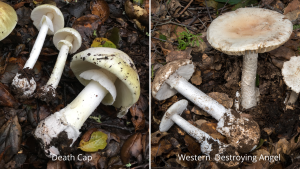Thinking Outside the Box: Leading the Way on Wildfire Protection for the Community
Groundbreaking Technology Being Used to Reduce Wildfire Risks
Updated December 7, 2023

The East Bay Regional Park District held a special briefing and tour at Anthony Chabot Regional Park today highlighting a first-of-its-kind fuels reduction project (365 acres) in the East Bay hills. The Park District’s wildfire fuels reduction project uses an innovative and climate-friendly carbonizer to dispose of vegetation with extremely low emissions, rather than conventional open-pile burning or transporting it long distances in diesel trucks.
In the fall of 2020, while conducting ongoing vegetation management work, Park District staff noticed significant tree die-off in its parks. Further investigation identified over 1,500 acres of tree mortality within Regional Parks, mostly eucalyptus, but also bay and pine. While there are many contributing factors, the overarching cause is believed to be drought-stress due to climate change.
“We were facing a crisis,” said Park District General Manager Sabrina Landreth. “I directed staff to assess the situation quickly and come together with a plan of action, including obtaining the necessary funding to begin addressing the die-off.”
The Park District spans Alameda and Contra Costa counties in the San Francisco Bay Area and manages 73 parks, 1,330 miles of trails, and over 126,809 acres. The District has its own fire department and fuels management crew.
“As the largest regional park district of its kind in the nation and a local wildfire prevention leader, we knew we needed to lead the way in finding solutions,” added Landreth.
Much of the identified tree die-off was within the Park District’s approved Wildfire Hazard Mitigation and Resource Management Plan, which meant environmental approvals for fuels reduction work were already in place. However, significant funding was needed.
In 2021, shortly after discovery of tree die-off, the District approached state officials for help addressing the situation, and the state responded with a critical $10 million direct appropriation from the legislature through Senator Nancy Skinner, D-Berkeley, and then-Senator Bob Wieckowski, D-Fremont. The total cost estimate to address the tree die-off issue is over $30 million.
“For a public agency to get a $10 million direct appropriation in the state budget for a specific purpose is extraordinary,” said Landreth.
Groundbreaking, Environmentally Friendly Tool for Fuels Reduction
As efforts to secure funding proceeded, estimates also soared for removal costs and the amount of organic material (biomass) that would need to be disposed of. Adding to the complexity of the situation was the fact that removing so much dead and dying vegetation by traditional means required hauling it in trucks to plants that would burn it for fuel. Transporting the dead trees was cost-prohibitive, disruptive to the residential areas, and potentially dangerous. It would also create greenhouse gases and pollution, causing some of the same environmental factors leading to increasing wildfire risks and perhaps even tree die-off itself.
The innovative solution the Park District found for processing large amounts of biomass was a carbonizer. The carbonizer machine, a Tigercat 6050, resembles a trucking container with a box-like metal chamber. The device burns organic matter with very little oxygen and at very high temperatures (about 1,300 degrees Fahrenheit), which breaks down the molecules of organic matter into a smaller material called biochar. The process creates extremely low emissions.
The resulting biochar – essentially elemental carbon – provides benefits, such as enriching soil by improving its water retention or pH, accelerating composting of green waste, and filtering toxins from water. The carbonizer, having never been used in a metropolitan area for biomass disposal at this scale, was tested as part of an 80-acre pilot project at Anthony Chabot Regional Park in 2022, with the lessons learned being shared with the state and other partner agencies facing similar challenges. When completed in March 2023, the pilot project proved to be a net positive, with only a tiny fraction of emissions compared to open-pile burning or hauling off-site.
“As a large regional park district with a full-time fire department and biologists and ecologists on staff, we can do work that other agencies can’t,” said Park District Fire Chief Aileen Theile.
“The carbonizer is another tool for our toolbox to reduce wildfire risks and combat climate change. Going forward, up to half of the biomass removed from parks could be converted into biochar,” said Park District Assistant Fire Chief Khari Helae.
Based on the success of the pilot project, a major fuels reduction project is underway at Anthony Chabot Regional Park on 365 acres and including the use of a carbonizer for biomass disposal. The project is using $7.5 million of the $10 million direct appropriation from the state legislature, plus federal funds of $1.5 million secured by U.S. Senator Alex Padilla (D-Calif.).
The 365-acre project currently underway at Anthony Chabot Regional Park involves heavy equipment, including a felling team removing trees from the top down and a mastication team thinning vegetation and trees from the ground up. The resulting biochar is being used at the Park District’s Ardenwood Farms in Fremont to enhance soil health, improve water retention, and ultimately increase productivity.
The innovative, strong partnership approach to securing funding, the use of the carbonizer in a pilot project and its subsequent use in a large-scale effort to reduce wildfire danger, and our desire to find a sustainable science-based solution in East Bay Regional Parks “is being seen as a model statewide, as well as nationally," said Landreth.
“By doing this work now, we will gain a more sustainable eco-system in the long-term to benefit generations to come. We are working and planning for both now and the future, and we’re committed to playing the long game,” said Landreth
The Park District’s leadership team, firefighters, scientists, park rangers, and dedicated staff across departments continue to focus on wildfire mitigation strategies and the innovative, large-scale fuels management program, all while seeking new partnerships and ways to protect the community.
Read the full-length feature article at www.ebparks.org/sites/default/files/carbonator-feature-article.pdf.
Media Resources: View more media resources, including b-roll, here.






